Human Orbital Spaceflights
![]()
International Flight No. 99STS-51ADiscovery (2)14th Space Shuttle missionUSA |
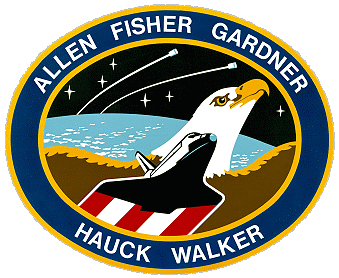 |
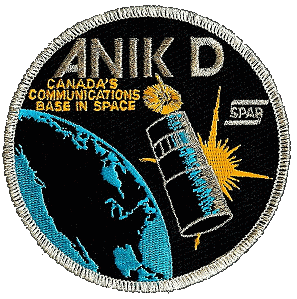 |
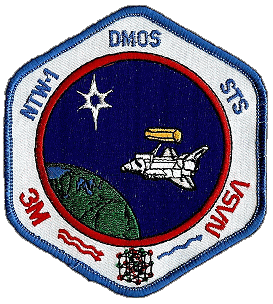 |
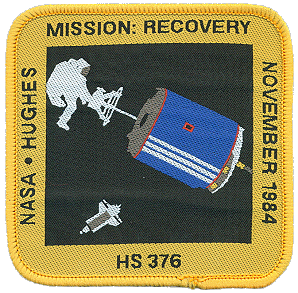 |
![]()
Launch, orbit and landing data
walkout photo |
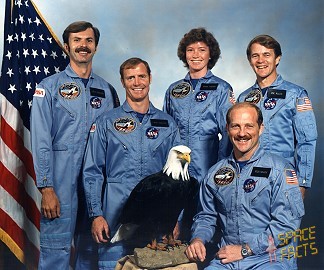 |
||||||||||||||||||||||||||||
alternative crew photo |
Crew
| No. | Surname | Given names | Position | Flight No. | Duration | Orbits | |
| 1 | Hauck | Frederick Hamilton "Rick" | CDR | 2 | 7d 23h 44m 56s | 127 | |
| 2 | Walker | David Mathieson | PLT | 1 | 7d 23h 44m 56s | 127 | |
| 3 | Allen | Joseph Percival IV "Joe" | MS-1, EV-1 | 2 | 7d 23h 44m 56s | 127 | |
| 4 | Fisher | Anna Lee | MS-2, FE, RMS | 1 | 7d 23h 44m 56s | 127 | |
| 5 | Gardner | Dale Alan | MS-3, EV-2 | 2 | 7d 23h 44m 56s | 127 |
Crew seating arrangement
|
 |
|
||||||||||||||||||||||||
Hardware
| Orbiter : | OV-103 (2.) |
| SSME (1 / 2 / 3): | 2109 (4.) / 2018 (3.) / 2012 (6.) |
| SRB: | BI-014 / RSRM 61-84 |
| ET: | ET-16 (LWT-9) |
| OMS Pod: | Left Pod 03 (3.) / Right Pod 03 (2.) |
| FWD RCS Pod: | FRC 3 (2.) |
| RMS: | 301 (2.) |
| EMU: | EMU No. 1051 (PLSS No. 1009) / EMU No. 1052 (PLSS No. 1007) / EMU No. 1054 (PLSS No. 1006) |
Flight
|
Launch from Cape Canaveral (KSC) and
landing in Cape Canaveral (KSC), Runway 15. A launch attempt the day before was scrubbed at the T minus 20-minute built-in hold because of high shear winds in the upper atmosphere. The STS-51A mission featured the deployment or the Canadian communications satellite Anik D2 (Telesat H) and the Hughes Leasat 1 (Syncom IV-1) communications satellite, both destined for geosynchronous orbit. The two satellites to be retrieved are the Palapa B2 and the Westar VI spacecraft which were deployed during Mission STS-41B in February 1984. After a successful deployment, failure of the Payload Assist Modules (PAM) attached to the satellites put them into unusable low-earth orbits about 600 miles above the Earth. The crew deployed the communications satellites Anik D2 (Canada) on flight day 2 and Syncom IV-1/Leasat 1 (US Navy) on flight day 3. Anik D2 was a spin-stabilized communications satellite of the cylindrical, drop-skirt design and is a sister spacecraft to the Anik D1 satellite launched by NASA on a Delta rocket in 1982. Both satellites use the PAM-D as a perigee kick motor for insertion into geosynchronous transfer orbit. The satellites are manufactured by Spar Aerospace Ltd. of Toronto, Ontario. Upon launch from the orbiter by springs, the 9-foot (2.74 meters) tall, 2,727-pound (1,236 kg) satellite began spinning at about 50 rpm for stability. About 45 minutes, or one-half earth orbit, later its PAM-D boost motor will be ignited by an onboard timer, kicking the satellite into an approximately 190-by-22,300-mile (305.7-by-38,888-km) elliptical orbit. At a selected high point in that orbit, another, smaller rocket motor inside the satellite will be fired by ground controllers to increase the satellite's speed and circularize the orbit at geosynchronous altitude of roughly 22,300 miles (38,888-km). Controllers then properly oriented the spacecraft, despin its antenna section to point at Earth, extend the lower skirt to expose additional solar cell banks and begin circuit testing in preparation for commercial use. After apogee motor burnout and all extensions, the satellite weighed 1,452 pounds (658 kg) and measure 21 feet, 5 inches (6.5 meters) tall. Final operational location will be over the equator at 111.5 degrees West Longitude, or almost due south of Salt Lake City, Utah. Leasat 1, also known as Syncom IV-1, was the second of four satellites which will be leased by the Department of Defense to replace older FleetSatCom spacecraft for worldwide UHF communications between ships, planes and fixed facilities. A Hughes 115381 design, Leasat spacecraft are designed expressly for launch from the Space Shuttle and utilize the unique "Frisbee" or rollout method of deployment. This particular spacecraft was to have been launched during Mission STS-41D, but was replaced by a sister craft to allow Hughes to replace a component in one of this satellite's UHF relay circuits. Installation of the spacecraft in the payload bay was accomplished with the aid of a cradle structure. The cradle permitted the spacecraft to be installed lying on its side, with its retracted antennas pointing toward the nose of the orbiter and its propulsion system pointing toward the back. Mounting the antennas on deployable structures allows them to be stowed for launch. Five trunnions (four longeron and one keel) were used to attach the cradle to the Shuttle. Five similarly located internal attach points are used to attach the spacecraft to the cradle. Another unique feature of the Leasat series of satellites was that they do not require a separately purchased upper stage, as have all the other communications satellites launched to date from the Shuttle. The Leasat satellites contained their own unique upper stage to transfer them from the Shuttle deploy orbit of about 182 s.mi. (292.9 km) to a circular orbit 22,300 s.mi. (38,888 km) over the equator. Each satellite was 20 ft. (6.09 meters) long with the UHF and omnidirectional antennas deployed. Total payload weight in the Shuttle was 17,049 lb. (7,733 kg). The satellite's weight on station at the beginning of its planned seven-year life was nearly 2,900 lb. (1,315 kg). Hughes Space and Communications Group builds the satellites. Ejection of the spacecraft from the Shuttle was initiated when locking pins at the four contact points are retracted. An explosive device then released a spring that ejects the spacecraft in a "Frisbee" motion. This gave the satellite its separation velocity and gyroscopic stability during the 45-minute coast period between deployment and ignition of the perigee kick motor. The satellite separated from the Shuttle at a velocity of 1.6 feet (0.49 meter) per second and a spin rate of about two rpm. Deployment of the Leasat satellite triggered an onboard automatic sequencer. The sequencer configures the satellite for firing of the solid propellant perigee motor. The telemetry, tracking and commanded antenna was deployed; attitude electronics, spacecraft power and telemetry were initialized; and the spacecraft spin rate was increased to 30 rpm. The satellites were spin-stabilized with the spun portion containing the solar array and the sun and earth sensors for attitude determination and Earth pointing reference, three nickel-cadmium batteries for eclipse operation and all the propulsion and attitude control hardware. The despun platform contained two large helical UHF Earth-pointing communications antennas, 12 UHF communication repeaters and the majority of the telemetry, tracking and command equipment. The orbiter then began a series of maneuvers to meet up with the first of the two satellites to be recovered, Palapa B2. The orbits of both satellites had been lowered by ground commands from about 600 miles (970 km) to 210 miles (340 km) to facilitate recovery operations. On day five of the mission, Discovery rendezvoused with Palapa. Frederick Hauck and David Walker maneuvered the Discovery to within 35 feet of the Palapa satellite. The first EVA by was performed by Joseph Allen and Dale Gardner on November 12, 1984 (6h 00m). This EVA to recover the 555-kg (1222-lb) Palapa B-2 satellite took place on mission day 5 with Jerry Ross as EVA CapCom, Anna Fisher on the RMS, and David Walker as support crewman. Joseph Allen donned the MMU and attached the stinger to its arms. He then flew to Palapa, inserted the stinger into the spinning, drum-shaped satellite's Apogee Kick Motor bell, and activated the MMU's automatic attitude hold feature to stop the spin. Joseph Allen and Dale Gardner cut off Palapa's omnidirectional antenna, then Dale Gardner, standing in an MFR on the RMS, attempted to attach the 2.44-m (8- ft) A-frame device, which stubbornly resisted his efforts. The astronauts stowed the A-frame and fell back on the backup plan; Dale Gardner grasped and held the satellite, then Anna Fisher guided him to the stowage frame intended to hold Palapa in Discovery's payload bay. Dale Gardner's gloves became abraded during the EVA because of friction from a knurled tool handle. The astronauts removed a bracket clamp from the A-frame during EVA closeout and took it into the airlock for examination in the crew compartment. Astronauts in the WETF began work to refine the backup satellite handling procedure for the Westar VI retrieval. Later investigation revealed that the A-frame was blocked by a Palapa waveguide extension that did not appear in the spacecraft blueprints. For the second spacewalk Joseph Allen and Dale Gardner left the Space Shuttle on November 14, 1984 (5h 42m). This EVA to recover Westar VI marks the final flight of the MMU. By the time Dale Gardner stowed the MMU, the two flight units had flown a total of 10 hours, 22 minutes in space. Joseph Allen and Dale Gardner ventured into Discovery's payload bay on mission day 7 with Anna Fisher again operating the RMS and Jerry Ross again serving as EVA CapCom. Dale Gardner flew the MMU to the 499-kg (1098-lb) Westar VI satellite and successfully stabilized it using the stinger and MMU. The astronauts left the omnidirectional antenna intact to serve as a handling aid. While Joseph Allen held the satellite on the RMS, Anna Fisher moved him to the back of the payload bay where the astronauts secured Westar VI for return to Earth. A torque wrench escaped when Gardner bumped a tether release button, but David Walker alerted him and he captured it before it could drift out of reach. In their postflight debrief, the crew noted that the EVAs were physically and mentally exhausting for all five STS-51A crewmembers. The crewmembers were involved throughout the EVAs and had no opportunities to rest or eat, they reported. They suggested that Shuttle crews of at least six were desirable for missions with complex EVAs. Joseph Allen and Dale Gardner reported that satellites were relatively easy for two crew to handle - in fact, they were easier to handle in some ways than the long, lightweight A-frame. Allen added that "As objects get smaller in space, they become more difficult to handle. It's really extraordinary how much easier it is to move more massive objects like satellites." Dale Gardner humorously held up a "For Sale" sign, as if trying to find someone to sell the malfunctioning satellites to. Both satellites were carried back to Earth and later (under a new name) again deployed. The satellite recoveries on STS-51A were the last untethered spacewalks until 1994, and marked the last use of the Manned Maneuvering Unit. In 1994, the Simplified Aid for EVA Rescue (SAFER) was tested on STS-64. On all subsequent spacewalks conducted by both NASA and the Soviet/Russian space agencies, the astronauts and cosmonauts were tethered to the craft by some means. One experiment during this mission was the Diffused Mixing of Organic Solutions (DMOS) experiment. It was the first of a series of comprehensive organic and polymer science experiments sponsored by the 3M Corp. This middeck experiment was successful and the proprietary results of the chemical mixes were turned over to 3M. One other experiment, the radiation monitoring experiment, was also performed. The DMOS experiment was conducted in six football-size, stainless-steel chemical reactors designed and built by 3M. Each reactor has three Teflon-coated chambers. Two experimental processes were conducted. In the first, an organic chemical in solution was contained in one endchamber of the reactor. The solution is allowed to diffuse into the two remaining chambers, which were filled with an incompatible solvent that causes the organic chemicals to crystallize out of the solution. In the second form of the experiment, two solutions of organic chemicals were contained in chambers on opposite ends of the reactor, separated by a center mixing chamber. As the chemicals in the end chambers were allowed to diffuse into the middle chamber, a chemical reaction takes place. The byproduct of the reaction was less soluble than the reactants and, therefore, was expected to crystallize out of the solution. Unlike Earth-bound experiments, the crystals formed in space are not subject to Earth's gravity and do not fall to the bottom of the reactor. Instead, they remain suspended, which should allow them to grow in size with exceptional purity. The Radiation Monitoring Equipment (RNA)B) consisted of hand-held and pocket-sized monitors which measured the level of background radiation present at various times in orbit. The two devices were self-contained and were powered by 9-volt alkaline batteries. At appointed times, the crew took and recorded measurements of any radiation which penetrates the cabin. RME devices have flown on numerous previous flights and are part of long-term studies of radiation exposure during spaceflight. On the final day in space, the crew completed cabin stowage, turn off experiments, close the payload bay doors over the two rescued satellites and prepare for the deorbit burn. |
EVA data
| Name | Start | End | Duration | Mission | Airlock | Suit | |
| EVA | Allen, Joseph | 12.11.1984, 13:25 UTC | 12.11.1984, 19:25 UTC | 6h 00m | STS-51A | Discovery | EMU No. 1051 |
| EVA | Gardner, Dale | 12.11.1984, 13:25 UTC | 12.11.1984, 19:25 UTC | 6h 00m | STS-51A | Discovery | EMU No. 1052 |
| EVA | Gardner, Dale | 14.11.1984, 11:0? UTC | 14.11.1984, 16:5? UTC | 5h 42m | STS-51A | Discovery | EMU No. 1052 |
| EVA | Allen, Joseph | 14.11.1984, 11:0? UTC | 14.11.1984, 16:5? UTC | 5h 42m | STS-51A | Discovery | EMU No. 1051 |
Photos / Graphics
 |
 |
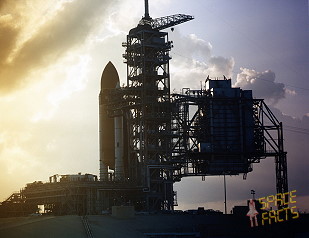 |
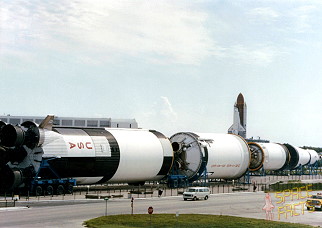 |
 |
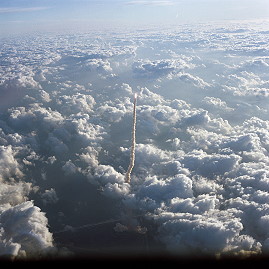 |
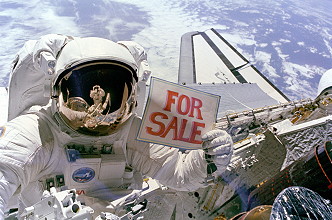 |
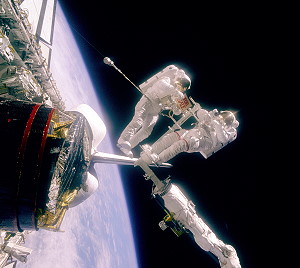 |
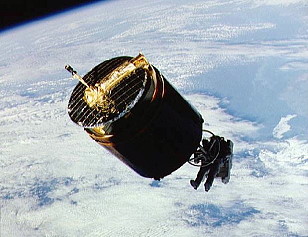 |
 |
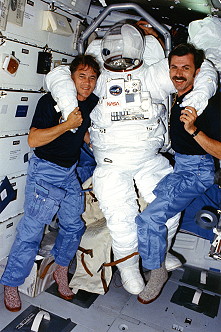 |
 |
 |
 |
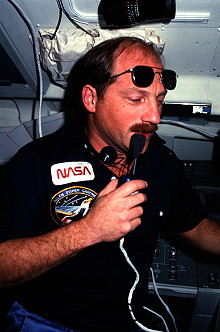 |
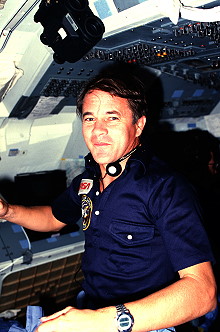 |
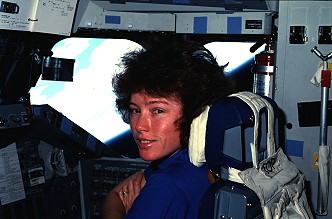 |
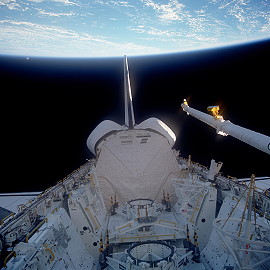 |
 |
|
more EVA photos |
|
| © |  |
Last update on June 23, 2023.  |
 |